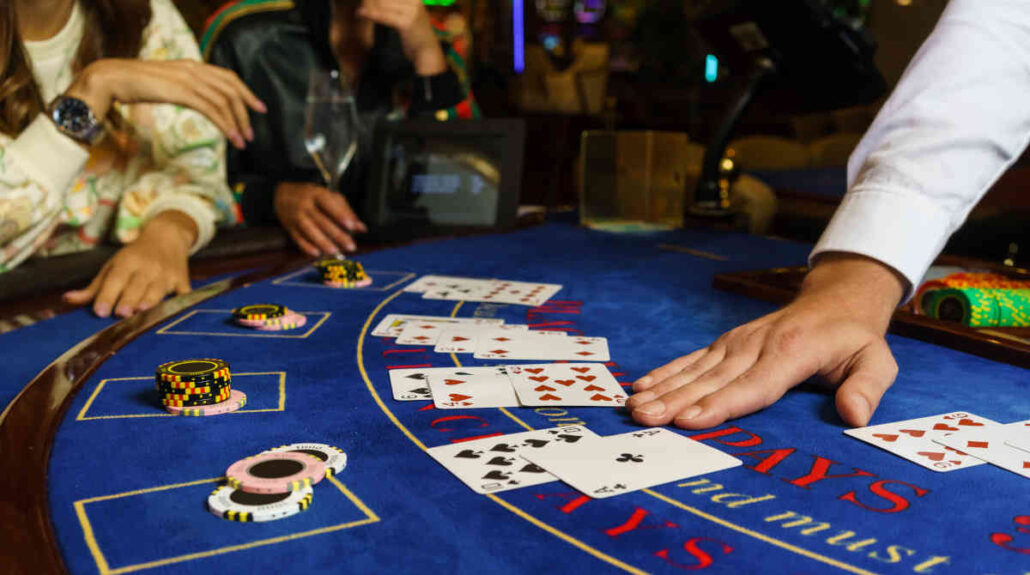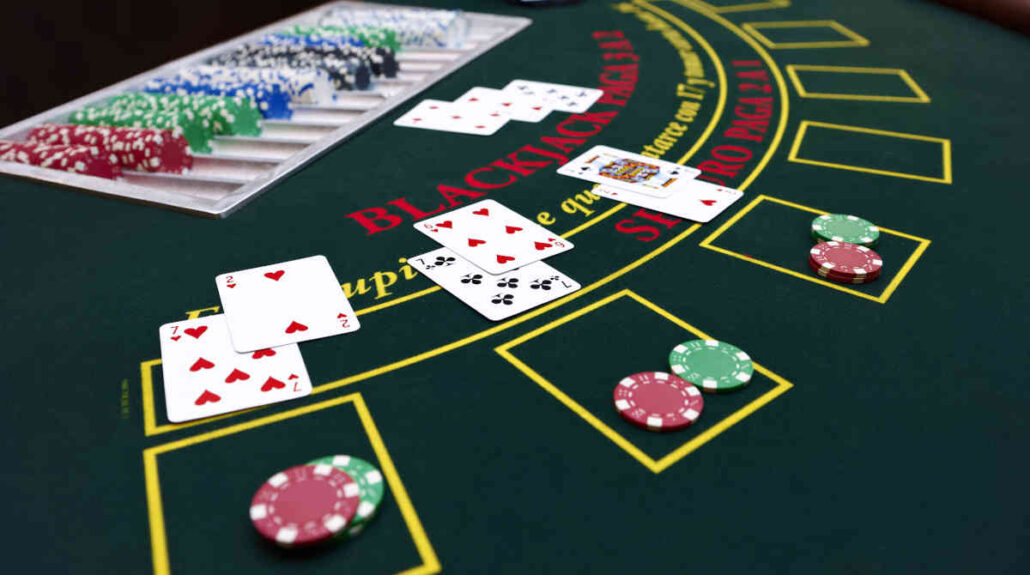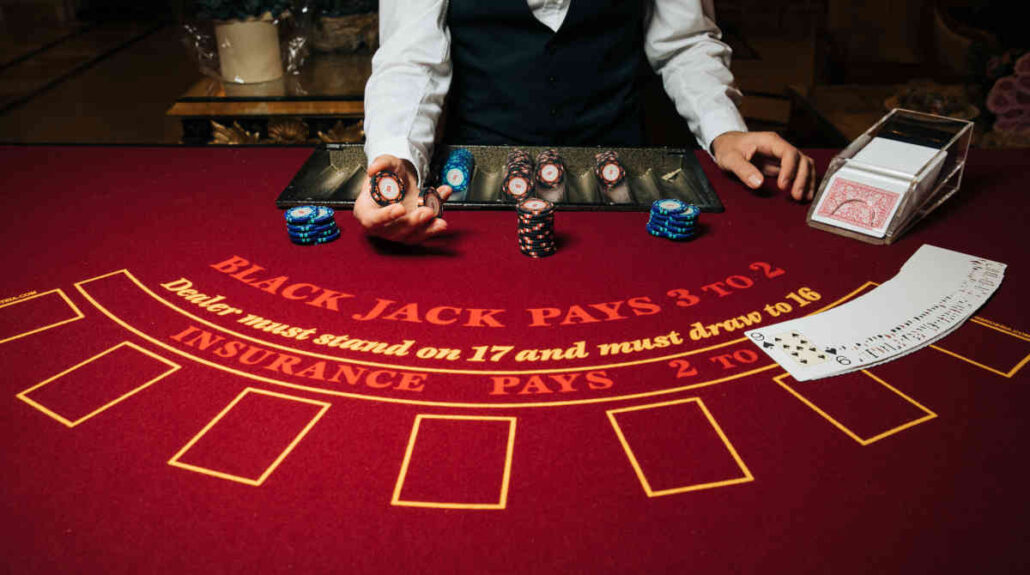Blackjack House Edge – What Advantage Does Dealer Have in Blackjack

When compared to other casino games, such as slots, Craps, Roulette, and Baccarat, the house edge in blackjack is rather low, as it can be brought down to as low as 0.5%.
This is significantly lower than the casino edge on European Roulette (around 2.7%), Craps (1.41%), and Baccarat (1.06% on the Banker’s side), all of which are considered low house edge games.
The exact house edge in the game of Blackjack depends on a number of factors, including the rules applied in the specific venue, and the strategy employed by the player.
Different Blackjack rules, such as the availability of early and late surrender, dealer hitting or standing on soft 17, and more can impact the eventual house edge and RTP rate.
However, in all cases, Blackjack offers one of the lowest house edges you will find in a casino, provided you play the game the right way.
In this article, I am going to discuss where the Blackjack house edge is derived from, how you can diminish it to the bare minimum, and why Blackjack is one of the best games for you to play in the pits.
Let’s get started!
What Advantage Does the Dealer Have in Blackjack? – Blackjack House Edge, RTP, and RNG

To understand what is the house edge in Blackjack, we need to examine what casino edge is in general and where the house derives its advantage from.
In the simplest terms, casino advantage or casino edge is a popular term that describes the long-term mathematical advantage that the casino has over the player when playing a particular game.
The house edge guarantees that the house is winning in the long run, provided enough bets are made and that money keeps circulating through the casino.
While casino games may be gambling for the player, they are pure business for the casinos, as they are guaranteed to make a profit off each game offered on the floor.
The more money circulates through the games, the more profit the casino makes, regardless of how things might be going for any particular player at any given time.
To understand what advantage does the dealer have in Blackjack games at online casinos, we also need to examine how Random Number Generator mechanisms work.
RNG Algorithm Behind Online Blackjack

In the simplest terms, a Random Number Generator is a computer that has been programmed to randomly pick numerical combinations ensuring fair play at all times.
While the RNG ensures randomness of each online Blackjack deal, it does not neutralize the Blackjack house edge, as random deals actually result in the casino having a slight advantage.
As the RNG produces random shuffles and deals, and gives the house its slight advantage, it also creates the reverse effect for the player, referred to as “Return to Player” or RTP rate.
The RTP rate is the number that represents the percentage of all bets made that go back to the players in the long run, and is the exact opposite of the house edge.
For example, if the house has an edge of 2% in a particular casino game, the RTP rate stands at 98% for that same game.
This means that if you were to wager a total of $100 at this table, you would end up losing $2 in the long run and getting $98 back.
Keep in mind that both the house edge and the RTP rate only realize in full over the long run, which means thousands, or even millions of hands.
Yet, you will feel the impact of a high or low house edge even over a smaller sample of hands, as a game like Blackjack will easily provide you with more wins and fewer losses than most other casino games.
What Is the House Edge in Blackjack? Real-Life Examples

To make the most out Blackjack each time you play, understanding the basics behind the house edge in Blackjack and other casino edge specifics is a must.
While the house edge in Blackjack may sound like just a number that doesn’t impact the results of each given session, the truth is quite the opposite.
When playing casino games, you should always be thinking about the size of your bet, the house edge of the game you are playing, and the theoretical loss rate you are incurring.
All players play casino games with the hopes of winning, but if you play too high for your bankroll, you may end up losing before you are even given a chance to get to the theoretical RTP rate.
For instance, if you are making $100 bets at a game with a 5% casino edge, you will be losing $5 per hand. Play 60 such hands per hour, and you are losing $300 per hour in the long run.
If you run under the average, you could be losing $500, $1,000, or even more playing this game, which means you will need a massive bankroll to sustain such losses.
By increasing your knowledge about casino edge and other factors that determine your winning odds, you are giving yourself the best chance to win or stay afloat until results catch up.
This also means exploring different Blackjack variants since their casino edge rates differ as following:
- Classic Blackjack: Lower than 1%
- Multi Deck Blackjack: 0.50% with the optimal strategy
- Blackjack Switch: 0.58%
- Double Exposure Blackjack: 0.67%
- Atlantic City Blackjack: 0.50%
- European Blackjack: 0.62%
- Spanish 21: 0.40%
- Free Bet Blackjack: 1%
- Vegas Strip Blackjack: 0.36%
Which Factors Determine the Blackjack House Edge? Single vs. Multi-Deck Blackjack Games

There are many factors that can impact the overall house edge in Blackjack, and the number of decks being used to spread the game is one of the key ones.
So, how does the number of decks impact the Blackjack casino edge? To understand this, we need to examine the concept of optimal play which is also something associated with many other casino games, such as Roulette and Craps.
There are different mathematical calculations powering the overall optimal concept play. In other words, given the player's cards and the dealer's up card, there is always an optimal move that benefits you the most compared to other plays.
Where Does the Edge in Blackjack Come From?
The RTP in Blackjack games is essentially based on players relying on this “Basic Strategy” alongside any potential deviations.
Needless to say, any potential deviations from optimal play reduce the overall RTP and lead to gambling establishments collecting bigger margins and profits.
Assuming the optimal play concept, the specific rules being followed will determine the RTP in Blackjack, and there are a variety of variables that potentially affect this.
Generally speaking, most online casinos offer Blackjack games with a house edge of between 0.4% and 1.5%, while it can be slightly lower with the most lenient regulations or significantly higher with those less lenient casinos that stack the deck to work in their favor.
While many different elements impact the Blackjack casino edge, the number of decks in play is one of the most important ones.
More specifically, the house edge in Blackjack games played with multiple decks is always higher compared to the house edge of a single-deck Blackjack game.
You may be wondering why this is the case and why the house edge goes up as the number of decks increases, and the answer lies in your chances to make a Blackjack.
Why Does Number of Decks Matter in Blackjack?
If you are playing single-deck Blackjack and you are dealt an Ace, there are 51 cards left in the deck, 16 of which have a value of Ten, which would give you a Blackjack. In this case, the likelihood of winning with blackjack is 16/51 or around 31%.
Now, assume you are playing a blackjack game that has eight decks and your first card is also an Ace. This leaves a total of 415 cards in the remaining decks, 128 of which have a value of Ten.
Your likelihood of making Blackjack in this case is 30.8% or 128/415. Essentially, your odds of getting a blackjack when you are playing multi-deck Blackjack games go down ever so slightly, which means the house edge also increases.
Single or Multi-Deck Blackjack?

Generally speaking, single-deck Blackjack games usually have a house edge lower by about 0.25%. While this may not seem very significant, the numbers add up in the long run, and Blackjack is a game of fine margins.
However, this does not mean you should avoid multi-deck Blackjack games, but rather modify your winning strategy accordingly.
Besides the number of decks in use, a couple of other factors determine the Blackjack house edge, such as:
- Dealer standing or hitting on soft 17 – RTP is reduced when the dealer hits;
- Splitting Aces – RTP is increased when allowed;
- Doubling on any first two cards – The RTP is increased when allowed;
- Doubling after splitting – The RTP is increased when allowed.
All of the factors listed here, combined with the total number of decks in the shoe, add up to create a house edge for a particular Blackjack game.
For optimal results, you should be on the lookout for games that offer the highest number of positive factors, such as low deck count, ability to split Aces, ability to double after splitting etc.
The more elements are in your favor, the more money you will be getting back while playing Blackjack, and the higher your overall RTP rate will be for the session.
How to Reduce the Blackjack House Edge?
When it comes to reducing the house advantage in Blackjack, it all comes down to using the right winning Blackjack strategy.
Using the correct strategy when playing Blackjack is essential, as playing badly can cause to losses much more significant than the approximately 0.5% you can achieve with optimal strategy.
To make the most out of Blackjack, you will need to know when to double down, when to split, in which cases to surrender, and exactly when to hit or stand.
For example, you can use the double down play to reduce the house edge by applying it in many cases when:
- You have a card total of 11;
- You have a hard 10 or 9;
- You have a soft 18, 17, or 16;
- Avoid when the dealer shows an Ace;
- Avoid with hands higher than 11.
Similarly, you should consider splitting when:
- You have a pair of Aces;
- You have a pair of 8s;
- Avoid splitting 5s, 4s, and 10s.
There are also other tips and tricks for reducing the Blackjack house edge, including knowing when to stand and hit.
You will need to learn the Basic Strategy of Blackjack before you get all of these right, and I highly recommend using a Blackjack cheat sheet while playing until you are completely comfortable with this strategy.
What’s even more, make sure you know the right strategy for the exact brand of Blackjack you are playing, as slight alterations in the rules can lead to modifications in optimal strategy as well.
If you want to get the absolute most out of Blackjack and always lose the minimum, while giving yourself the best possible winning chance, use every trick in the book and play Blackjack like the pros.




